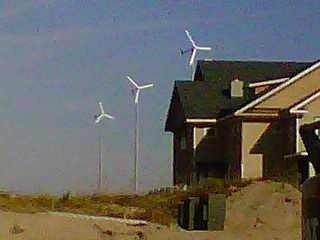Democrat Tim Kaine of Virginia recently visited the Roanoke
waste-water treatment plant. He used this
setting to discuss his vision for America’s energy future. His opponent in this year’s senatorial
election, Republican George Allen, advocates reducing restrictions on existing
energy resources such as coal, oil, and natural gas.
The reason for this particular setting is what Roanoke is
doing with its waste-water… it is turning it into methane to provide 7577
megawatt hours annually of electricity. According
to the Roanoke Times, the Western Virginia Water Authority anticipates that the
generators will pay for themselves within seven years, a very quick pace for
alternative energy sources.
While biomass energy is a proven technology, it requires
more labor than the casual reader might suspect. First, the feedstock for biomass must be
replenished after a few weeks. That requires monitoring, switching tanks, and
discharging the sludge for further processing.
Also, hydrogen sulfide, a byproduct must be removed prior to
using the methane as fuel. This is
typically accomplished with the use of a metal “sponge” that chemically bonds
with the sulfur, stripping it from the fuel.
However, biomass is increasing in popularity once the full
process has been accounted for in the planning process. The beauty of this system is that it takes
waste that was a problem and turns it into a solution.
Democrat Tim Kaine of Virginia recently visited the Roanoke
wastewater treatment plant. He used this
setting to discuss his vision for America’s energy future. His opponent in this year’s senatorial
election, Republican George Allen, advocates reducing restrictions on existing
energy resources such as coal, oil, and natural gas.
The reason for this particular setting is what Roanoke is
doing with its wastewater… it is turning it into methane to provide 7577
megawatt hours annually of electricity. According
to the Roanoke Times, the Western Virginia Water Authority anticipates that the
generators will pay for themselves within seven years, a very quick pace for
alternative energy sources.
While biomass energy is a proven technology, it requires
more labor than the casual reader might suspect. First, the feedstock for biomass must be
replenished after a few weeks. That requires monitoring, switching tanks, and
discharging the sludge for further processing.
Also, hydrogen sulfide, a byproduct must be removed prior to
using the methane as fuel. This is
typically accomplished with the use of a metal “sponge” that chemically bonds
with the sulfur, stripping it from the fuel.
However, biomass is increasing in popularity once the full
process has been accounted for in the planning process. The beauty of this system is that it takes
waste that was a problem and turns it into a solution.
Read more about it in renewablesbiz.com: http://www.renewablesbiz.com/article/12/08/kaine-tours-alternative-energy-site-roanoke








